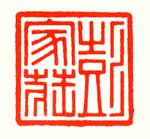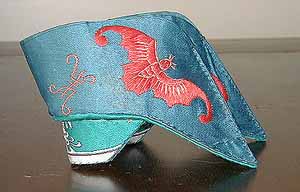 |
PENG VILLAGE ANTIQUES NEW YORK, NY |
 |
PENG VILLAGE ANTIQUES NEW YORK, NY |
Feature of the Month
19th-century Chinese Bound
Feet Shoes

Foot binding was first introduced in the eleventh century and spread from the wealthy Chinese classes to those of more modest means and to much of the peasantry. Girls as young as three or four would have their feet bound tightly with long strips of cloth bandages, folding all the toes except the big one under the sole to make the foot appear narrow and dainty. As men became infatuated with the beauty of the crescent foot, slender and pointed at the toe, foot binding continued to spread even though the Mongols, who came to power in 1279, outlawed the practice. For Chinese women, foot binding was the price for a good marriage. The sight of a woman teetering on her little points, moving her hips from side to side "like a tender young willow in a breeze" to balance herself was believed to have an erotic effect upon men. The making of tiny embroidered shoes to wear on bound feet became a domestic skill passed down from mother to daughter, and it seems to have led to pride and aesthetic pleasure among both women and men.The pair of bound feet shoes featured this month are hand- embroidered with red bats on a blue silk background. The bat has traditionally been a symbol of wealth and prosperity in Chinese culture. The origin of this symbolism derives from a homonym of the second character in the Chinese name for "bat" - "Bian Fu" - with the character for "fortune" - also pronounced "Fu." Although visually distinctive when written, these two characters for "bat" and "fortune" are aurally identical when spoken.